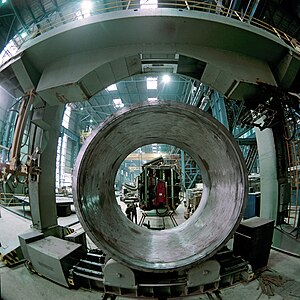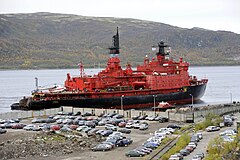


Nuclear industry of Russia is a major national high-technology industry, mostly centered around the Rosatom state corporation. It consists of 200 enterprises and organizations and employes over 250,000 people, providing the full range of nuclear-related products and services: uranium mining and enrichment, nuclear fuel production and repocessing, nuclear power plants construction and exploitation, production of nuclear reactors and other power generation equipment, nuclear waste disposal, nuclear weapons making, nuclear marine propulsion, nuclear medicine, and nuclear research.
Ever since the success of the Soviet atomic bomb project in 1949, and the launch in 1954 of the first civilian nuclear power plant in the world, the country has been a world leader in in nuclear technology. A massive program of nuclear power plants construction was undertaken from the 1960s to the 1980s, and was resumed in the late 2000s. The country operates 33 large reactors at 10 power stations, produducing 17,09% (155,1 TWh) of the national energy output (as of 2010), with a number of reactors and stations under construction. The vast majority of the equipment is produced domestically.
Russian nuclear companies operate both at home and abroad, constructing nuclear plants in many countries of the world, such as China (Tianwan), Iran (Bushehr) and Belarus. Russian Uranium Holding Atomredmetzoloto holds the world's second place in explored uranium reserves (546,000 tons as of January 1, 2009), concentrated in Russia, Kazakhstan, Mongolia, Namibia, Canada, United States and a number of other countries.
Russia has competetitive advantages in uranium enrichment, reactor design and construction, with the tightest safety measures in the world. The country provides nuclear waste disposal services to many states, and is the leader in nuclear fuel repocessing as well as the only operator of commercial fast-neutron reactors which are powered by the processed fuel. Apart from having a large nuclear submarine navy, Russia is also the only country to have civilian nuclear fleet, composed of nuclear icebreakers which provide year-round navigation in the Arctic Ocean and through the Northern Sea Route. The recent Russian nuclear projects include the construction of mobile nuclear plants and the development of nuclear space propulsion.
History
Early developments
Russian and Soviet nuclear research dates back to 1918, when the so called Department Number One was set up with the Russian Academy of Sciences Committee for natural and production resources. Its primary activity was the exploration of rare and radioactive materials. In 1920 an atomic committee was organized on the base of the department. Its first session was attended by several outstanding Russian scientists, including physicist Abram Ioffe, the founder of the Soviet physics school. In 1921, the State Scientific Council with Commissariat of Enlightenment founded Radium laboratory, which would become Radium Institute of the Soviet Academy of Sciences. Vitaly Khlopin was its first head.[1]
The advances in nuclear science were spurred by the first all-Soviet conference on nuclear physics, held in Leningrad in 1933. In 1934, Alexander Brodsky produced the first heavy water in the Soviet Union, and in 1935 Igor Kurchatov discovered nuclear isomerism. The first cyclotron in Europe was installed at Radium Institute, and by 1937 it produced the first accelerated proton beam. In 1939, Yakov Zeldovich, Yuly Khariton and Alexander Leipunsky proved feasibility of uranium fission chain reaction. On 28 September 1940, the Academy of Sciences approved the start of the first Soviet uranium project.[1]
Soviet atomic bomb project

After the German invasion and the start of the Great Patriotic War, all nuclear research in the Soviet Union was suspended. However, following a number of letters to the state leader Iosif Stalin written by physicist Georgy Flyorov,[2] where he pointed out the conspicuous silence within the field of nuclear fission in the United States, Great Britain and Germany (all developing their own uranium projects then), the State Defense Committee (GKO) decided to resume the nuclear physics studies by the secret order № 2352ss, signed on 28 August 1942 and setting a goal for the Academy of Sciences to research "the possibility of creating a uranium bomb or uranium fuel".[1]
On 12 April 1943, the Instrumentation Laboratory No. 2, which would develop into Kurchatov Institute, was established with the Academy of Sciences, with Igor Kurchatov as its scientific leader. The routine management of the work was carried out by Mikhail Pervukhin, a Deputy Chairman of the government, and Sergey Kaftanov, the GKO Commissioner for Science. Vyacheslav Molotov overlooked after uranium research on behalf of the top Soviet leadership. The activities at that time included geological surveys, studies in uranium fission physics, isotope separation, radiochemistry and uranium metallurgy. In 1944 Kurchatov obtained the first detectable amount of plutonium in the USSR.[1]
However, due to the limited resources of war time, the attention given to uranium project was insufficient. The situation changed only after the Soviet victory over Germany and the nuclear bomb tests conducted by the USA in July 1945. The Soviet Union had to answer this new challenge, and by the order № 9887ss of August 20, 1945, GKO established the Special Committee that included statesmen and physicists. The top-level control of the program was transferred from Molotov to Lavrenty Beria. The First General Directorate (PGU), headed by Boris Vannikov, was set up with the Soviet Government to manage the organizations and facilities involved in the uranium studies and A-bomb production; that is considered the start of the Soviet nuclear industry.[1]
The four years of heroic efforts by Soviet scientists and engineers ensued: in 1946, the team of Kurchatov achieved the first self-sustained uranium chain reaction in Eurasia, which led in 1948 to the creation of the first 100 MW Reactor A at facility № 817 (now Mayak Production Association) in Ozersk, while the first Soviet nuclear charge, RDS-1, was successfully detonated at the Semipalatinsk Test Site on August 9, 1949. That restored the military parity with the United States and made nuclear deterrence possible. The first Soviet testing of a hydrogen bomb, RDS-6s, was successfully conducted in Semipalatinsk in 1953.[1]
Soviet nuclear industry

In 1953, the Special Committee, the First, Second and Third General Directorates joined into the Ministry of Medium Machine Building, headed by Vyacheslav Malyshev. The successful development and testing of the nuclear weapons opened the door to the civil nuclear power. The world’s first nuclear power plant was put into operation in Obninsk (near Moscow) in 1954. The plant – a 5 MW uranium-graphite pressure-tube reactor AM cooled by water – was built under Igor Kurchatov’s leadership. The reactor got its name AM from the abbreviation of Russian words meaning ‘peaceful atom’. The core design concepts belonged to Kurchatov; chief designer was Academician Nikolai Dollezhal.
In June 1955, Igor Kurchatov and Anatoly Alexandrov headed development of the Soviet nuclear power program. The program was aimed at the large-scale use of atomic energy for electricity generation, transport and other civil applications. The world’s first fast neutron zero power reactor BR-1 was put in operation in 1955, and a year later another fast neutron reactor – a 100 kW BR-2 started operation. The key nuclear institutions were set up at that time, including Institute of Theoretical and Experimental Physics (Moscow), Joined Institute of Nuclear Research (Dubna), Institute of Physics and Power Engineering (Obninsk), Research Institute of Inorganic Materials (Moscow).

The Kurchatov Institute provided the scientific guidance and support for construction of the first nuclear submarine (Project К-3, in 1957) and development of a new shipbuilding line – nuclear icebreakers which provided year-round navigation in the northern seas. The first nuclear-propelled icebreaker Lenin was launched in 1959.
Construction of nuclear power units was going at a brisk pace. The first 210 MW unit was put on line at Novovoronezh NPP in 1964. The world’s first fast power reactor BN-350 was commissioned in Shevchenko (now Aktau in Kazakhstan) in 1973. A year later, the first 1000-MW RBMK reactor was put in operation at the Leningrad NPP. Extensive construction of large NPPs was deployed in the Eastern Europe.[1]
A serious accident that occurred at the Chernobyl plant in April 1986 all but stopped nuclear power advancement.
Post-Soviet adjustments

Soviet and global nuclear power went into deep recession in the 1990s, falling into stagnation. In late January 1992 the Russian part of the former Soviet Ministry of Atomic Energy and Industry (the successor to the Ministry of Medium Machine Engineering) was transformed into the RF Ministry for Atomic Energy. The new Russian Ministry headed by Viktor Mikhailov inherited approximately 80% of the enterprises and 28 nuclear power units at 9 sites.
It was the time when the industry had to restore the economic and production links broken during the recession, build new manufacturing plants to replace the facilities lost to Russia, adapt to the new internal and external economic conditions. The work was centered on top-priority lines, and allocations were optimized to support principal activities. Owing to this, the industry survived the hard times and managed to keep its potential and human resources.
The first unit of Rostov NPP was brought to criticality in February 2001. [1]
Revival and Rosatom era

In March 2004, the Russian President issued order №314 to establish the Federal Atomic Energy Agency. The first head of the Agency was Alexander Rumyantsev, and on November 2005 this position came over to Sergey Kirienko.
New ambitious goals were set for the Federal Agency. On October 6, 2006, the Russian Government passed order № 605 to approve the federal program on the Development of Nuclear Power and Industry Complex of Russia in 2007-2010 and until 2015, according to which 26 new nuclear power units are to be commissioned in the country before 2020.
The Presidential order established State Atomic Energy Corporation "Rosatom" (shortly ROSATOM) in December of 2007. On March 26, 2008 the Corporation took over the functions and authorities of the abolished Federal Atomic Energy Agency. Sergey Kirienko was appointed the Director General of the new Corporation. In August 2008, the federal state unitary enterprise (FSUE) Atomflot (in charge of nuclear-propelled fleet and support ships) was transferred to ROSATOM.
ROSATOM implements Government policy, provides integrated control over the use of atomic energy, ensures stable operation of civil and defense nuclear facilities, takes care of nuclear and radiation safety. It is also responsible for fulfilling the international commitments of Russia on the peaceful use of atomic energy and non-proliferation. ROSATOM is called for to facilitate the effective implementation of the federal target program for nuclear industry development, create new environment in support of this development and strengthen the country’s competitiveness on the global market of nuclear technology.[1]
Structure
Companies
Research institutions
Products and services


Uranium and nuclear fuel
Reserves and mining
Enrichment
Nuclear fuel fabrication
Nuclear energy generation

Reactor design
Reactor construction
Other equipment

Safety measures
Nuclear plants

Nuclear plants in Russia
Nuclear plants abroad

Mobile nuclear plants
Nuclear waste and processed fuel

Nuclear waste disposal
Nuclear fuel reprocessing
Nuclear weapons
Nuclear propulsion equipment
Marine nuclear propulsion


Nuclear submarines
Nuclear icebreakers
Space nuclear propulsion
Nuclear medicine


Nuclear research
Export
References
See also
External links

- Nuclear industry at the official Rosatom site

